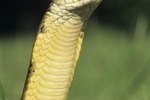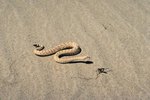
Four different species of venomous snakes reside in the United States. These include the cottonmouth or water moccasin, the copperhead, the rattlesnake and the coral snake. Even though snakes bite an average of 45,000 people a year, venomous snakes bite only 18 percent of that number.
Rattlesnakes
According to wildlife expert Jules Sylvester, the Mojave rattlesnake is the deadliest of all rattlesnakes with venom that can kill a person if antivenin isn't administered. These rattlesnakes are aggressive toward humans and will bite without provocation. Although rattlesnake venom isn't as deadly as some other snakes', the volume of the injected venom makes rattlesnakes particularly dangerous. The venom is haemotoxic, meaning that it prevents blood from clotting and destroys tissue.
Relatives of the Mojave rattler include the Eastern diamondback, Western diamondback, sidewinder, timber, rock, and pygmy rattlesnakes. Known for their distinctive rattle at the end of the tail, rattlesnakes can strike at amazing distances and catch their victims by surprise. Mojave rattlesnakes can reach a length of 50 inches.
Coral Snake
For venom power, the most dangerous is the cousin to the cobra called the coral snake. These snakes live in the southern part of the United States, stretching from Florida to Arizona. They are small snakes, measuring 39 inches or less. Their fangs are undersized, so many coral snakes are unable to penetrate skin. Fewer than one percent of deaths due to snakes are from coral snake bites. Their venom causes paralysis -- in particular, of the respiratory system -- and weakness.
The saying "red on yellow kills a fellow" identifies coral snakes from other colorful snakes such as nonvenomous milk snakes, king snakes and scarlet snakes. The coral snake has red, yellow and black bands; if the red band and the black band are separated by a yellow band, you are looking at a coral snake.
Water Moccasin/Cottonmouth
The cottonmouth or water moccasin is a less deadly snake that has earned a reputation as being aggressive. These snakes will bite if provoked, but are more likely to flee than bite. Their venom is haemotoxic and their bites cause gangrene. These snakes live in the wetlands, primarily in the Southeast. These are semi-aquatic snakes, preferring swamps, ditches, lakes and rivers.
Cottonmouths were given this colorful name because they flash the inside of their whitish or cotton-colored mouths in warning. These snakes are between two and a half to four feet in length.
Copperheads
Copperheads are the most common venomous snake in the eastern half of the United States. They also cause 37 percent of venomous bites in the US. If bitten, you'll experience pain, but their bites are usually less serious than other venomous snakes.
Preventing Snake Bites
Wearing long heavy pants and shoes with leather reinforcement will help protect you from snake bites. Avoid tall grasses, thick marshy areas and areas that are known snake habitat. Don't put your hands in places where you can't see. If you see a snake, leave it alone and give it plenty of room to escape. If you get bitten, seek immediate medical attention.
References
- America Now News: The Deadliest Snake in North America
- Google: North America's Most Venomous Snakes
- Venomous Snakes: Rattlesnake Facts: More Bites but the Same Number of Fatalities
- Venomous Snakes: Fatalities, Attacks, Teeth, and Fangs
- Trailquest.net: Poisonous Snakes
- Red on Yellow Kill a Fellow—or so the Coral Snake Saying Goes
- Cottonmouth Snake:Ambusher of the Wetlands
- Copperhead: Attacks, Venom, Life-cycle, Habitat, Bites & Heat Sensitive Pits
Photo Credits
-
Jupiterimages/Photos.com/Getty Images




